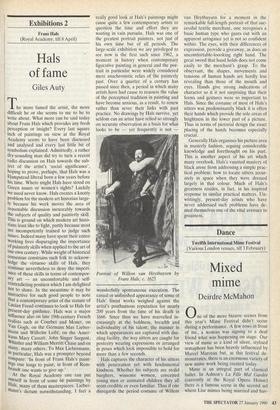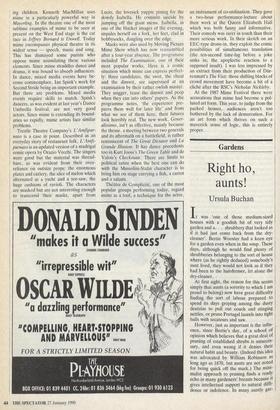Dance
Twelfth International Mime Festival (Various London venues, till 3 February)
Mixed mime
Deirdre McMahon
0 ne of the more bizarre scenes from this year's Mime Festival didn't occur during a performance. A few rows in front of me, a woman was signing to a deaf friend what was happening on stage. Our view of mime as a kind of silent, stylised semaphore has been heavily influenced by Marcel Marceau but, as this festival de- monstrates, there is an enormous variety of new mime work being created today.
Mime is an integral part of classical ballet. In Ashton's La Fille Mal Gardee (currently at the Royal Opera House) there is a famous scene in the second act where Lise mimes being married and hav- ing children. Kenneth MacMillan uses mime in a particularly powerful way in Mayerling. In the theatre one of the most sublime examples of mime to be seen at present on the West End stage is the cat race in Jeffrey Bernard is Unwell. Today mime encompasses physical theatre in its widest sense — speech, music and song. This has dismayed some purists who oppose mime assimilating these various elements. Since mime straddles dance and drama, it was bound to absorb influences. In dance, mixed media events have be- come commonplace, Ian Spink's work for Second Stride being an important example. But there are problems. Mixed media events require skills to match. Spink's dancers, as was evident at last year's Dance Umbrella festival, are. not very good actors. Since mime is extending its bound- aries so rapidly, mime artists face similar problems.
Trestle Theatre Company's L'Amfipar- naso is a case in point. Described as an everyday story of restaurant folk, L'Amfi- parnaso is an updated version of a madrigal comic opera by Orazio Vecchi. The singers were good but the material was thread- bare, as was evident from their Over- reliance on outsize props: the enormous plates and cutlery, the slice of melon which alternated as a yacht and a see-saw; the huge cushions of ravioli. The characters are masked but are not interesting enough to transcend their masks, apart from
Lucia, the lovesick yuppie pining for the dowdy Isabella. He commits suicide by jumping off the giant menu. Isabella, in one of the blacker images of the evening, impales herself on a fork, her feet, clad in bobbysocks, dangling over the edge.
Masks were also used by Moving Picture Mime Show which has now reassembled after a four-year absence. The programme included The Examination, one of their most popular works. Here is a comic situation which mime can express perfect- ly: three candidates, the swot, the cheat and the dimwit, are supervised at an examination by their rather owlish master. They snigger, tease the dimwit and peep when they can into others' papers. As the programme notes, 'the experience pre- pares them well for later life' and from what we see of them here, their futures look horribly real. The new work, Gener- alissimo, isn't as effective, mainly because the theme, a meeting between two generals and its aftermath on a battlefield, is rather reminiscent of The Great Dictator and La Grande Illusion. It has dance precedents too in Kurt Jooss's The Green Table and de Valois's Checkmate. There are limits to political satire when the best one can do with the Mussolini-Stalin character is to bring him on stage carrying a fish, a carrot and a salami.
Thehtre de Complicite, one of the most popular groups performing today, regard mime as a tool, a technique for the actor,
an instrument of co-ordination. They gave a two-hour performance-lecture about their work at the Queen Elizabeth Hall which was both funny and informative. Their comedy was surer in touch than their more serious work. In their sketch on an EEC-type drone-in, they exploit the comic possibilities of simultaneous translation (the ten-second time-lag before a joke sinks in; the apoplectic reaction to a supposed insult). I was less impressed by an extract from their production of Diir- renmatt's The Visit: those shifting blocks of crowd movement have become a bit of a cliche after the RSC's Nicholas Nickleby.
At the 1987 Mime Festival there were accusations that mime had become a pol- luted art form. This year, to judge from the packed houses, audiences aren't too bothered by the lack of demarcation. For an art form which thrives on such a maverick sense of logic, this is entirely proper.



























































 Previous page
Previous page